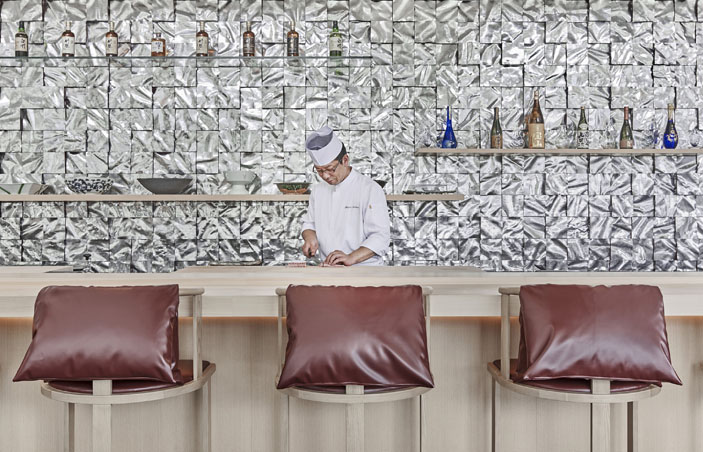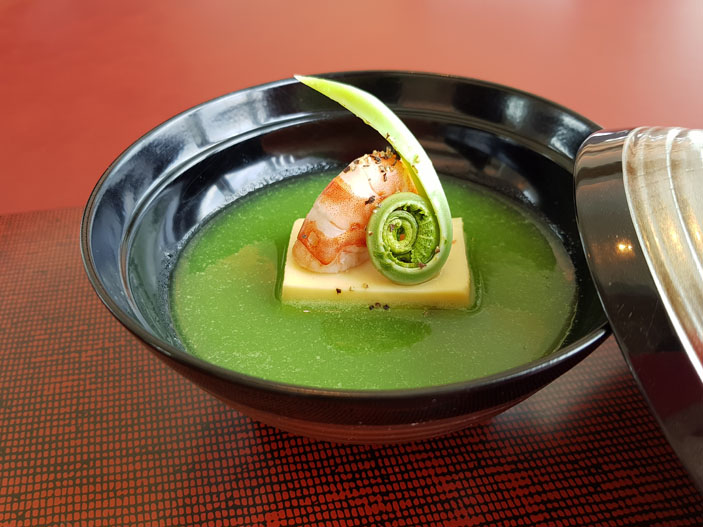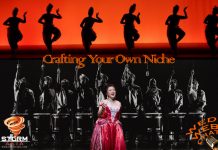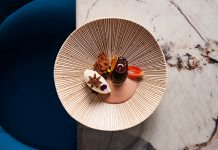FOR THE discerning palate, there’s more to Japanese food than what’s been flooding our shores.
One of the early adopters of the cuisine in Singapore, the Shangri-La featured Nadaman Restaurant at the top of its building, almost like a jewel in its crown. It was subsequently pushed to the ground floor.
But following a major renovation, the Japanese wave has risen to the top, this time under the name of NAMI and with a fresh perspective on Japanese cuisine.
Minimalism with highlights
With the sun streaming in, this restaurant on the 24th floor of the hotel makes good use of its view of the upmarket neighbourhood, creating a classy yet chic ambience. The 96-seater restaurant is open for lunch and dinner, and guests on the terrace can stay out till midnight.

At the helm at NAMI is Yokohama chef, Shigeo Akiba, who has an impressive resume. In his three decades as a chef he has prepared royal banquets, created meals for celebrities, and has worked under Iron Chef Koumei Nakamura.
The Special Ingredient
Having picked up cooking at his mother’s elbow as a child, Chef Akiba brings some of his homecooked fare to the table at NAMI. He also brings his secret ingredient to NAMI — his recipe for dashi stock, or the “broth of life”.
His dashi is made from kombu (seaweed) from the sea off northern Hokkaido and three types of katsuobushi from Kyushu, from a producer who only selects one in 10,000 skipjack tuna to be fermented and aged. The resulting umami, or deliciousness, is so good, there’s a dash of dashi in many of the dishes.

With this dashi as the base, Chef Akiba brings in seasonal specialities from a number of sources that he has forged strong relationships with over the years. The ingredients are air-flown from Tokyo’s famous Tsukiji market (recently on fire, but the main market was spared), Kyushu and Hokkaido.
You Might Also Like To Read:
Healthy Eating — At What Cost?
Whole Snapper In Kecap Manis — Whip It UP!
Seasonal Specials
Depending on the season, you could be enjoying sea urchin, horsehair crab and asparagus from Hokkaido, or Saga Wagyu beef from Kyushu.
Allowing the freshness of the produce do a lot of the work, Chef Akiba creates a masterful array of dishes juxtaposing ingredients in such a way they are not only tasty, but visually appealing for this era of social media storytelling.

A meal that is so Instagram friendly, it’s inevitable that cameras will be whipped into action. The natural light flooding in during lunch is certainly helpful.
The Edomae sushi served up follows the traditional Tokyo style. Some of the seafood is aged to increase umami, and heighten the appreciation of their true qualities. Others, like squid, are all about their freshness.
The Saga Wagyu Beef Sirloin A4 with Sea Urchin and Chef Akiba’s special sauce on rice and topped with seasonal truffle looks splendid when served, is mixed up on the plate and brings together a variety of tastes that have to be savoured slowly to be enjoyed.
Enhanced Flavours
The Miso Penshell Clam with Sea Urchin and Salmon Roe brings to the table a dish that is based on old family recipes. The mix of textures and flavours again highlight Chef Akiba’s ability to bring to the fore the strongest points of the ingredients.

And this goes for the smallest of ingredients, too. The Utogi wasabi is from the Shizuoka prefecture and is considered top class, with 1kg selling for around $250 (normal wasabi costs around $100 for 1kg). The pickles accompanying some of the dishes include yamaimo, or slimy mountain yam, for that fresh, crunchy texture.
Dessert, as in most Japanese restaurants, is fairly predictable. Again, it’s the quality of the fare that sets NAMI’s apart.
Regal Pours
Complementing the food is a selection of Japanese sake, shochu and whiskies. The Born Chogin is one to savour for a very special treat. This sake is made in limited numbers and presented to the Imperial House. Yours to be had for $1,000. If you’d prefer something humbler, the Kiss Of Fire weighs in at $310. Or you could have a $15 glass of the peach or orange drinks in huge bottles that have a pleasant 7—8% alcohol content.

Guests can enjoy waves of umami at prices upwards of $45. For the Omakase meal, priced at $190 per head, the number of courses ranges from five to six, depending on season and the day’s catch.
NAMI, Level 24, Tower Wing, Shangri-La Hotel, Singapore 22 Orange Grove Road, Singapore 258350 Reservations : Tel: (65) 6213 4398 Email: dining.sls@shangri-la.com
























